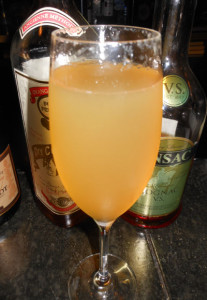Recipe of the Day
Testimonials
If you’re a Syfonatic or a frequent visitor to our site, you know we’re not bashful about touting the health benefits of sparkling water. But it’s always a good idea to get a second opinion. In a recent article, the website Medical Daily highlighted some of the benefits of the bubbles including:
Better than soda – Well we’ve been saying this all along: Since sparkling water doesn’t contain any artificial sweeteners or sugar, it’s healthier than soda. Not to mention just as tasty and refreshing with our four delicious flavors of Syfo Naturally Flavored Sparkling Waters.
Blood sugar control – Per a 2015 study, bicarbonate from carbonated water in the body is also known to regulate our body’s glucose levels. Just check out our testimonials to read how Syfo has been a dream drink for diabetics.
Helps with digestion – According to the Medical Daily website, sparkling water can aid an upset stomach from either illness, indigestion or even motion sickness. Research has also shown that sparkling water can help improve gall bladder emptying and constipation.
So feel good, feel refreshed and feel healthy at the same time. Click here to try some great Syfo recipes to enjoy while staying healthy and hydrated. You can read the entire Medical Daily article here.
It’s not just about soda anymore. CNN reports that a new study links drinking too many sugary beverages – including 100% natural fruit juices — to an increased risk of early death.
If you think switching from soda to natural fruit juices is a healthier step, this study published in the JAMA Network Open will give you pause. It specifically highlights that drinking an excessive amount of fruit juice could lead to an increased risk of premature death ranging from 9% to 42%. Overall, the study indicated that sugars found in orange juice, although naturally occurring, are pretty similar to the sugars added to soda and other sweetened beverages.
People who consumed 10% or more of their daily calories from sugary beverages had a 44% greater risk of dying due to coronary heart disease and a 14% greater risk of an early death from any cause compared with people who consumed less than 5% of their daily calories from sugary beverages, the study showed.
Each additional 12-ounce serving of fruit juice per day was associated with a 24% higher risk of death from any cause, and each additional 12-ounce serving of sugary beverages per day was associated with an 11% higher risk. “Sugary beverages, whether soft drinks or fruit juices, should be limited,” Jean A. Welsh, a co-author of the study and an assistant professor in the Department of Pediatrics at Emory University in Atlanta, wrote in an email to CNN.
Of course, as we’ve pointed out in prior posts, you don’t have to deprive yourself of everything sweet and tasty. No matter what sugar-laden beverage you are used to drinking , be it your favorite carbonated beverage or favorite fruit juice, you can add a bigger portion of Syfo to cut the sugar to a healthier level and still enjoy a refreshing juice drink. Better yet, replacing fruit juice and other sugary beverages with Syfo Naturally Flavored Sparkling Waters can help you beat that sugar craving entirely. With deliciously refreshing flavors like Lemon- Lime, Wild Cherry and Tangerine Orange, you won’t even miss those sweet fruit juices or that soda.
You can read more about the study in this article.
The New York Times has a feature called Smart Living Guides and we think this one is really smart – How to Stop Eating Sugar. If you’re a regular visitor to our site you know that this is one of our favorite topics. Consumption of sugary drinks has led to obesity, diabetes, heart disease, tooth decay and more and Syfo has helped people kick the soda habit and lead healthier lives.
This guide in the Times takes a whole-day approach, from the start of your day with breakfast through that desert and late night snack. Here are some of the highlights:
Breakfast tips
The Times points out that for people used to a grain-based breakfast (cereal or toast) avoiding sugar can be hard, since most commercial grains are packed with added sugar. Still there are plenty of things you can do — such as going with low-sugar cereals and breads, homemade granola or plain oatmeal. You can also move away from the grains entirely and indulge in a breakfast of eggs, fruit, plain yogurt and a small portion of vegetables.
The beverage factor
This is where Syfo comes in. According to the federal government, 47 percent of the added sugar in the American diet comes from beverages. The article also quotes an obesity expert at the Sanford School of Public Policy as saying that the science is robust on linking soft drink consumption to negative health outcomes.
The New York Times wisely recommends sparkling water and seltzer as healthy alternatives and says the switch from soda to these beverages can be life-changing. As you can see in our testimonial section, Syfo customers couldn’t agree more.
Sugar in the main course
We’ve identified plenty of sugar sources and we haven’t even gotten to dessert yet! Food makers sneak sugar into more foods than you may realize. It’s in many brands of chicken stock, soup, salami, smoked salmon, tortillas and crackers. And most of these foods do not need sweeteners to taste good.
If you take a little time to look at labels — at the grocery store or online — you can quickly learn which staples have sugar and which don’t. Try planning your meals around foods and ingredients that have as a little sugar as possible.
And that includes what goes on top of the food
Other than breakfast items, sauces and toppings are the biggest hidden sugar risks. Everything from ketchup to Ragu has lots of added sugar. Barbeque sauces, pickles and Dijon Mustard have a bunch too! The takeaway here? Read the label (or check the article for a sugar-safe list) or make your own.
The end of the meal
Now you could have done everything right so far and ruin all that effort at the end of the meal. Desserts are sweet by nature but you don’t have to deny yourself an occasional treat. The Times recommends monitoring portion size (American desserts have become grotesquely large over the years) and watching your habits, like getting used to having a bowl of ice cream each evening). Or mix up your habits by substituting fruit for dessert on occasion.
At the end of the day
We all get those late in the day cravings but what you snack on can make all the difference in the world. Many granola bars and power bars are packed with added sugars. The same goes for canned and dried fruits. And don’t kid yourself about those flavored Starbucks drinks – they’re more a like a milkshake than a cup of coffee. The article recommends going with nuts, popcorn, fresh fruit or options like Larabars or Rxbars that have no extra sugar.
Or do what we do, just grab a bottle of one of Syfo’s four delicious flavors of Naturally Flavored Sparkling Waters, they’re both satisfying and refreshing. You can read the full New York Times article here for more beating back sugar tips.
This is the time of the year where we make resolutions to live healthier and rein in some of our indulgences. Although there is nothing wrong with coffee in moderation, if one of your 2019 goals is to cut down on the amount of java you consume throughout the day, here are some suggestions courtesy of this article from the Southland Sun:
Sparkling Water
We just had to put this one first. The article opines: “Sparkling water can be a refreshing alternative to both coffee and water. Especially when flavored with natural, sugar-free, fruit extracts, sparkling water is delicious and hydrating.” Sounds like Syfo to us!
Kombucha Tea
Kombucha is a type of yeast. When you ferment it with tea, flavors, sugar and other ingredients you get Kombucha tea. While the health benefits of Kombucha are being debated, many claim that it is useful for treating memory loss, regulating bowel movements, preventing cancer and lowering high blood pressure.
Probiotic Drinks
According to the article: “These sparkling beverages provide different strains of active cultures of live probiotics. Researchers say that some digestive disorders happen when the balance of friendly bacteria in the intestines becomes disturbed. This can happen after taking antibiotics. Probiotics are said to help counteract this. They regulate digestive health, boost the immune system, maintain gut health and more.”
Tea
Yep, good old-fashioned, straight-up tea can be great for an afternoon pick-me-up instead of brewing that extra pot of coffee. Teas come in a myriad of forms and blends and can be drunk hot or cold. There is a wide selection of green, black, herbal and specialty teas out there, many of which are caffeine-free and are naturally sweet enough to skip the sugar. Many teas are a well-known source of antioxidants, B vitamins and minerals.
Hot Apple Cider
Hot apple cider’s sweet tanginess offers its own unique pick-me-up in lieu of caffeine, and its soothing warmth is just as satisfying as that cup of coffee on a cold morning. In addition to its natural sweetness, because apples are the key ingredient, apple cider offers health benefits not available in coffee.
Coconut Water
The article states: “Coconut water is a clear, milky liquid that comes from green, young coconuts. Coconut water is naturally sweet, contains bioactive enzymes and is chock full of rehydrating electrolytes, which makes it a good replacement for sugary sports drinks.
So if you’re looking to cut down on the coffee consumption, Syfo is a great sugar, calorie, and caffeine-free, healthy alternative that can help you stay hydrated!
People often assume that natural flavors contain only natural ingredients. But that might not always be the case.
What can be called natural flavors is defined by law, and essentially the FDA says that any flavor extracted from a natural source, such as a fruit, spice, vegetable or seafood, can be called natural. In other words, the flavor wasn’t cooked up synthetically in a laboratory. However, that doesn’t mean that flavors called natural can’t also contain some unnatural additives.
Take the case of Hint Water, which was recently the target of a class action suit that charged they were deceptive in how they represented their product as “all-natural”. The company’s flavors are natural as defined by the FDA, but they also use propylene glycol (PG) — a synthetic substance used in cosmetics and food. And while synthetic solvents such as propylene glycol are not allowed in the production of organic certified products, they are permitted in “natural flavors.” The reasoning is that they are incidental additives present in food at an insignificant level. Although PG is FDA-approved, there is concern in some quarters about the potential negative health effects of the substance.
With Syfo there is no confusion. All of our natural flavors are propylene glycol free. We opt for vegetable based glycerin and/or ethyl alcohol (derived from grain) instead. There are no preservatives, artificial colors, or flavors used in the manufacturing of our flavors. That makes Syfo the clear choice.


 "Thank you Syfo Original. I discovered you on a hot, humid August in Georgia. I have been hooked since. The glass bottle is the key for, it seems to hold the carbonation."
"Thank you Syfo Original. I discovered you on a hot, humid August in Georgia. I have been hooked since. The glass bottle is the key for, it seems to hold the carbonation."